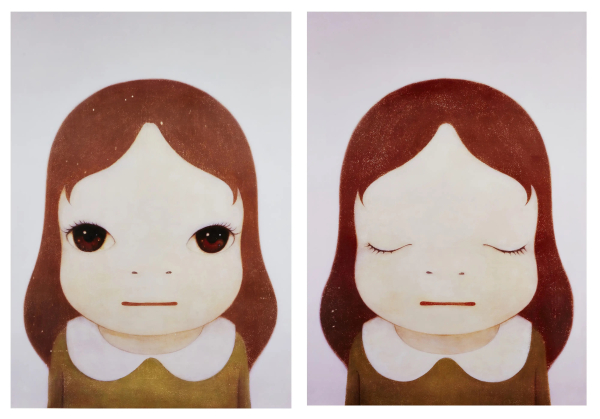Born in Hirosaki in 1959, Yoshitomo Nara is best known as a key figure in Japan’s Pop Art movement of the 1990s and for his wide-eyed childlike figures which straddle the line between Japanese anime (which the artist has interestingly always denied the influence of) and traditional fine art portraiture. His characters demonstrate a range of emotions and capture within them both a rebelliousness and a shyness. As well as in painted portraits, Nara’s figures have featured in sculptures, soft toys, photographs, and drawings. The artist has collaborated with the design collective ‘graf’ on several occasions.
His childlike figures are decidedly adult, showing a deep awareness of themselves in the world and their emotions often bordering on existential crises. There are elements of dark humour in their seemingly cute exterior, some even hold weapons. The artist’s own childhood came at an interesting time for his country – a post-war landscape which was flooded with Western culture while reeling from wartime atrocities. Nara grew up in Aomori Prefecture in a rural neighbourhood and was often left alone as a child while his parents worked. The figures in his work are often cited as reflections of the artist’s inner child and the complex environment in which he grew up.
Nara studied at the Aichi University of Arts and at the Kunstakademie in Düsseldorf. His time in Germany (living there for twelve years up to 2000) cemented the artist’s interest in creating works which combine Western and Eastern art history. His focus on pop culture motifs is typical of a German approach to art history, in which all elements of visual life are studied and celebrated. Other influences on Nara’s work are childhood memories, politics, and music. During his childhood Nara was exposed to Western music through a local American military radio station, and the artist would later design album covers for several Western bands including REM.
The artist’s work casts a critical eye on globalisation, consumption, and the causes of natural disasters like the Great East Japan Earthquake and Tsunami. After the 2011 disaster, Nara’s figures took a distinctly pensive turn, and his work tackled a meditative urge towards tranquillity and transience.
He has been displayed internationally, with his works in the collections of MoMA, the Baltic Centre, and LACMA. He has had nearly 40 solo shows in as many years, and his highly praised solo exhibitions ‘I don’t mind, if you forget me’ (2000) and ‘Nothing ever happens’ (2003) had highly successful tours through Japan and the US respectively. In just a matter of hours in 2019, the record price for Nara’s works was broken twice. First for his installation ‘Not Everything but / Green House’ (2009) which sold for $5.12 million at Poly Auction Hong Kong and shortly after for ‘Knife Behind Back’ (2000) which sold at Sotheby’s in Hong Kong for $25 million, making Nara the most expensive Japanese artist of all time. The artist lives and works in Nasushiobara, and a comprehensive online catalogue raisonné of all of Nara’s work was completed in 2021 which can be viewed on the artist’s website.
